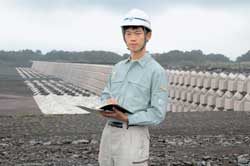| Web Japan > NIPPONIA No.35 > Special Feature* |
|
|
|
NIPPONIA No.35 December 15, 2005 |
|
Special Feature*
Life with Mount Fuji
Some people admire it from afar, some make their living on it, some try to protect its beauty. Others tell of its many faces—its awesome power and its natural resources. These pages introduce just a few of these people. Their lives are quite different, but they have one thing in common: they all love Mount Fuji.
Written by Torikai Shin-ichi and Wada Yasunari
Photos by Minamioka Hideo, Kono Toshihiko and Kawashima Yasuhiko
|

Right: Tashiro Hiroshi admiring his favorite mountain from the observation lounge on the 25th floor of the Bunkyo Civic Center in Bunkyo-ku, Tokyo.
Left: The top of Mount Fuji looms over skyscrapers in Shinjuku, Tokyo. Taken from the same observation lounge, using a strong telephoto lens which makes the mountain appear closer than it really is.
(Photo: Tashiro Hiroshi)
|
|
Happiness is seeing Mount Fuji
Tashiro Hiroshi, teacher, Senior High School, University of Tsukuba
“It's more to be seen than climbed,” says Tashiro Hiroshi. He looks toward Mount Fuji every morning, hoping it is visible.
He looks from his home in Yokohama before going to work, at the station when commuting, and from the roof of the high school where he works in Tokyo. And he keeps a record of what he sees at each place.
His “Diary of Fuji Sightings” website was launched in 1994 and gets more hits every year. A few dozen people have followed his example, setting up their own Fuji Diaries on the web.
“People ask why it's such a pastime for me, and my only answer is that I enjoy it. Sometimes I can see it really clearly, and there's something exciting about that. Other days, you can't see it at all, but you can still look forward to the next time!”
What does he like best about it? “Its spectacular profile and its snowy covering in winter.” I've been keeping a record of my sightings for more than a decade. On average, I'd say you can see it about a hundred days a year from the Tokyo area.
“Of all the countries in the world, Japan is just about the only one where the highest mountain in the country can be seen from its national capital,” says Tashiro, his eyes lighting up like a proud schoolboy's.
|
|
Can we protect ourselves from a future eruption?
Ito Motoki, Research Section Head, Sabo Works at Mt. Fuji
Sabo Works at Mt. Fuji was established to prevent damage from landslides on the mountain, and in 2002 it was given another job as well—to try to minimize damage from a future eruption.
Now they are working on a project to build lava barriers, considering how to change the direction of future lava flows and stop cinders and rocks from cascading down onto places needing protection. Their work is still in the planning stages—studying past eruptions, examining the present contours of the mountain, making eruption simulation models.
Ito Motoki says, “Mount Fuji is huge, and the next time it erupts the lava could be ejected in any direction—north, south, east or west.”
Analyzing simulations to predict future flow patterns takes a lot of time. Their data came in useful in 2004 during work on the hazard map ordered by the national government's Cabinet Office, and during fiscal 2005 they intend to complete an action plan for the construction of lava barriers.
What should local people do the next time the mountain wakes up? “A volcano is not like an earthquake—it almost always sends out some sort of signal before it makes any major trouble. So if you follow evacuation instructions you'll be OK. The important thing is not to panic,” says Ito calmly.
|
|
||||||
|
